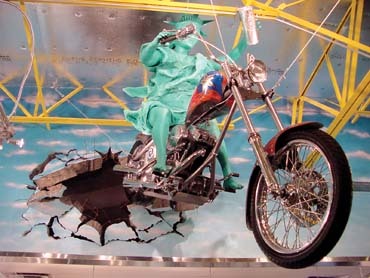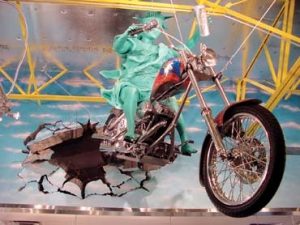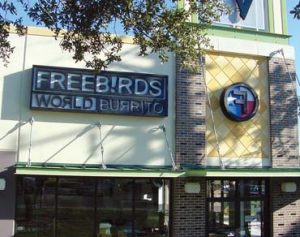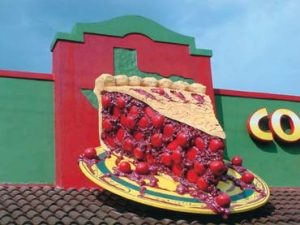Design
Bigger in Texas
Great Big Signs does gargantuan work with a small staff.
Published
18 years agoon

Texas' ponderous geographic span creates a unique collage of topography, culture and history. From Dallas' fine-tuned commercial engine to Austin's vaguely bohemian cultural scene to the far-reaching beauty of the West Texas hill country, the Lone Star State has inspired a diverse array of legendary figures, such as pioneering rock 'n' roller Buddy Holly, Hall of Fame baseball pitcher Nolan Ryan and Star Trek creator Gene Roddenberry. Thanks to the shop's innovative sculptures, 3-D signs and environmental graphics, signmakers can count Lynn Wilkerson and Mario Munoz, co-founders of Kyle, TX-based Great Big Signs, among Texas' progeny of creative talent.
Getting started
A native of Amarillo, TX, Wilkerson was first artistically inspired by one of his grandfather's friends, who worked as a "snapper" (an old-school signpainter who traveled in search of employment). The snapper's car was quite an impressive calling card — he'd handcarved replicas of Native American headdresses and bolted them to the front and rear fenders. "Big Tex," the 52-ft.-tall cowpoke who greets visitors to the Dallas-based Texas State Fair, also inspired Wilkerson to design and build.
"In West Texas, making signs wasn't something someone normally aspired to," he recalled. "In fact, many of Texas' old-time signmakers received their training at the Huntsville Penitentiary, where they had a sign-education program."
Undeterred, Wilkerson earned a scholarship to Western State College's art school, where he learned the basics of environmental-graphic design. However, circumstances short-circuited school, and he joined an Oklahoma City-based company. His first supervisor, Troy Zumbro, a perfectionist, helped Wilkerson become a better signmaker.
"He'd just look over my shoulder and say things like, 'We need to start that again,' or 'I don't think that looks right,' and I would have to start over," he said. "Most of the time, though, I was the gopher or brush washer, and I would just try to spy on them and learn the techniques."
He also credits Ellison Edwards, owner of Abilene, TX-based Edwards Sign Co., with helping him develop a sense of professionalism. In competition with Edwards for jobs, Wilkerson frequently lost, despite lower bids. Edwards explained, "You show up looking like a dropcloth. I wear a button-down shirt and tie."
AdvertisementHe opened his own shop, The Signtist, in Snyder, TX, in 1979. He'd established a solid clientele for carved and sculpted, 3-D signage, but the region's rough economic times forced a change.
"A lot of the oil fields started to dry up in that area in the late '80s and early '90s," he recalled. So it was necessary for me to look elsewhere for work."
Wilkerson commuted weekly to Austin and found steady work with Austin Outdoor Advertising. Eventually, he developed Austin Sign & Pictorial as an additional business for the company. Though its dimensional-sign business grew steadily, it relied on billboards for a large portion of its business until the mid-'90s. Then, inkjet-printing technology quickly dominated the large-format market; handpainted billboards would soon be as obsolete as Royal typewriters.
In 1993, Wilkerson left Austin Outdoor and established Great Big Signs as a partnership with Mario Munoz. They focused their work on sandblasted and sculptured signage, as well as creating graphic identities.
In its 3,400-sq.-ft. shop, the company operates a 30 x 18-ft., enclosed sandblasting booth with an integral air-compressor system. Predictably, donning a respirator and safety gloves in a 100°F Lone Star steambath makes even the most experienced, physically fit fabricator a prime candidate for heatstroke.
Thus, Wilkerson said mere self-preservation necessitates proper ventilation and preventing potential ingestion of silica sand. He, Munoz or Aaron Leblanc, the company's fabrication assistant, also broil when they operate the shop's MIG welder to craft signage elements. To help ventilation, the shop's fans blow and expel air with wind-tunnel intensity, Wilkerson said.
In addition to the standard signshop repertoire of chisels, dowels and saws, Great Big Signs also owns a 24-in. Gerber Scientific Products enVision™ cutting plotter, which it operates with Corel Corp.'s CorelDRAW™ Graphic Suite 12. Wilkerson likes the software's versatility; any text or graphics stored on his PC can be output through the program. Though the shop will create designs for such programs, it generally outsources its digital graphics and electric-sign work to a trusted subcontractor.
Advertisement"A shop really needs to concentrate on what it does best and maintain relationships with different types of shops to do the rest," he said.
Free as a bird
Fortunately, Great Big Signs found a like-minded, unorthodox enterprise for symbiotic growth. Founded in 1987 in Santa Barbara, CA, Freebirds World Burrito offers gourmet burritos and related, Mexican-style accompaniments. The company, which is now headquartered in College Station, TX, operates 15 locations throughout Texas, and plans to open four to six stores during each of the next two years.
In 1997, Freebirds hired an architectural-design firm to decorate the stores' interiors and contracted Great Big Signs to fabricate the graphics. Two years later, Freebirds President Allan Hixon said the company chose to retain the shop exclusively because some of the other firm's designs weren't sufficiently functional.
The Freebirds inhouse design team and Great Big Signs delicately balance a common theme through each Freebirds location while providing a unique sense of place. Each restaurant incorporates the chain's central icon, Libby (a revved-up version of Lady Liberty, riding proudly on a custom Harley and bedecked in a less matronly shroud than its New York Harbor inspiration), as a ceiling-mounted sculpture.
"We create an initial template for each individual store, and then we'll meet with Great Big Signs to add and omit elements based on their feasibility," Hixon said. "Usually, when the store's construction is around 50% complete, we'll break out the blueprints and conceptual renderings, and refine the environmental-graphic concept."
Libby hosts a variety of guests — for instance, one of Freebirds' Austin locations features Willie Nelson (a sculptural likeness, that is) cruising the scene in the sidecar on Libby's bike. In the Lubbock location, which was slated at presstime to open in May, a Buddy Holly mural commingles with Libby, and the lyrics to several of his hits will be applied to the wall in black, acrylic paint with 4-in. hand rollers.
Other eye-catching elements include ceiling-suspended, winged guitars and laptops (the latter playfully underscores the restaurants' wi-fi accessibility); airbrushed, cloudy-blue skies; "broken" facades and paintings of local heroes.
AdvertisementGreat Big Signs sculpts these from EPS foam. The shop uses molds to create the legs and arms, whereas the torsos are custom-made to allow greater design flexibility. The shop casts the material in Master Maché, which is as pliable as paper maché, but is tougher and dries more quickly.
After removing the EPS sculptures from the molding, Wilkerson applies a coat of Poly-Tech's two-part epoxy, which prevents the next layer, a resin coating, from eating through the base foam. Wet sanding is done between coatings, and high-build primer preps the surface for a green-patina finish.
MIG-welded, steel armatures function as support structures. To suspend the sculptures high above Freebirds' customers, the shop mounted a 1,000-lb., channel-iron framework that's welded to wall joists, and 3⁄8-in. aircraft cable supports them.
Sculptures and Tinseltown
Though Freebirds occupies approximately half of Great Big Signs' time and energy, the shop takes on numerous other, ambitious projects. When Kyle-based Texas Pie Co. sought a bold sculpture for its building façade, it didn't travel far to find a fabricator. During his site survey, Wilkerson determined the building needed greater dimension to appear bigger.
The shop used EIFS — an EPS-foam, mesh-finish, moisture-resistant material that's sometimes used in monument signage and "faux" architecture — to construct ornamental columns, which it masked with Anchor Continental #16 stencils and sandblasted in the Texas shape and "Lone Star" insignia. These were painted with acrylic-latex paints. The 3-D letters comprise stud-mounted, epoxy-finished EPS foam.
To make local residents salivate, Great Big Signs rendered an epicure's dream — a 3 x 6-ft. slab of cherry pie. After having applied a urethane basecoat to the sculpture, the shop gave the sculpture its vivid tones with 1Shot® lettering enamels. Great Big Signs affixed the pseudo-confection to a fiberglass plate that's MIG-welded to a steel armature.
To give the Texas Pie Co. a coordinating color scheme, Wilkerson painted the building's exterior with complementary colors. After the installation, the client affirmed the power suggestion — cherry-pie sales surged 85%.
A sculpture for an Austin, TX, consignment shop truly stands, ahem, hangs out. The Lost Cat Co.'s owners needed a strong graphic identity. Appropriately, Wilkerson designed a slightly haggard-looking, yellow, brown and white-striped feline sculpture, which evokes the title protagonist and junkman's pet in the children's novel Pyewacket.
Great Big Signs fabricated the feline similarly to the pie piece, but it features a flexible, elastomer-foam coating typical of projects that are safe from accidental contact. A channel of stainless-steel bolts seamlessly supports one of the cat's "legs," which hangs down from the roof, and holds it flush to the wall. And, to replicate a cat's thin, protruding ears, the shop fashioned cold-rolled, steel that's easily bent into shape.
The shop has also enjoyed a few "big screen" moments. It's registered as a contractor with the Texas Film Commission, and one of its more notable recent efforts will surface in Idiocracy, a film from King of the Hill creator Mike Judge that's due for release later this year.
The story centers around an average man, portrayed by Luke Wilson, who's sent 1,000 years into the future, where he finds a populace that's degenerated to a collective moronic state. For the film, Great Big Signs created a deliberately ugly sign for the "Time Masheen [sic]," which was acid etched for a distressed appearance, and incorporates a mishmash of sign types and unattractive letter styles. For instance, Wilkerson contracted a neon tubebender to improperly create a couple letters and allow impurities "to make the sign dim and flickering, like it's on its last legs."
Great Big Signs also helped create a homespun, small-town scene by devising HDU and MDO building signage for Smithville's town square in 1998's Hope Floats, which starred Sandra Bullock and Harry Connick Jr.
In the future, Wilkerson will strive to keep his work fun and roll with the punches.
"Making signs has allowed me to lead a good life and hold a satisfying job," he said. "There have been a lot of changes in the industry, but I think as long as we keep doing good work and pursue work that we find enjoyable, we'll handle the twists and turns."Gerber Scientific ProductsCorel Corporation

SPONSORED VIDEO
Introducing the Sign Industry Podcast
The Sign Industry Podcast is a platform for every sign person out there — from the old-timers who bent neon and hand-lettered boats to those venturing into new technologies — we want to get their stories out for everyone to hear. Come join us and listen to stories, learn tricks or techniques, and get insights of what’s to come. We are the world’s second oldest profession. The folks who started the world’s oldest profession needed a sign.
You may like

ISA Announces New Tradeshows and Meetings VP

5 Reasons to Sell a Sign Company Plus 6 Options

Sign Products Wrap-Up for April
Subscribe

Bulletins
Get the most important news and business ideas from Signs of the Times magazine's news bulletin.
Most Popular
-

 Tip Sheet1 week ago
Tip Sheet1 week agoAlways Brand Yourself and Wear Fewer Hats — Two of April’s Sign Tips
-

 Ask Signs of the Times2 days ago
Ask Signs of the Times2 days agoWhy Are Signs from Canva so Overloaded and Similar?
-

 Real Deal1 week ago
Real Deal1 week agoA Woman Sign Company Owner Confronts a Sexist Wholesaler
-

 Benchmarks5 days ago
Benchmarks5 days ago6 Sports Venue Signs Deserving a Standing Ovation
-

 Editor's Note2 weeks ago
Editor's Note2 weeks agoWhy We Still Need the Women in Signs Award
-

 Women in Signs1 week ago
Women in Signs1 week ago2024 Women in Signs: Megan Bradley
-

 Product Buying + Technology2 weeks ago
Product Buying + Technology2 weeks agoADA Signs and More Uses for Engraving Machines
-

 Photo Gallery6 days ago
Photo Gallery6 days ago21 Larry Albright Plasma Globes, Crackle Tubes and More













